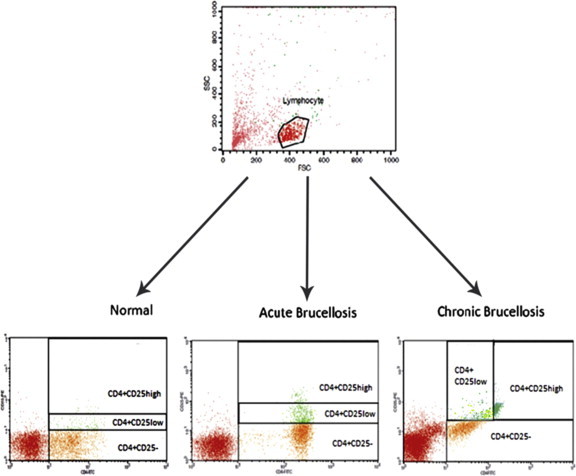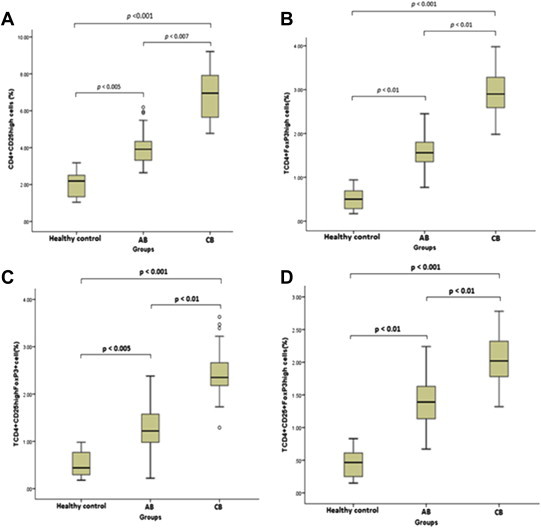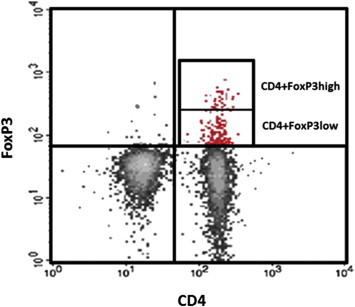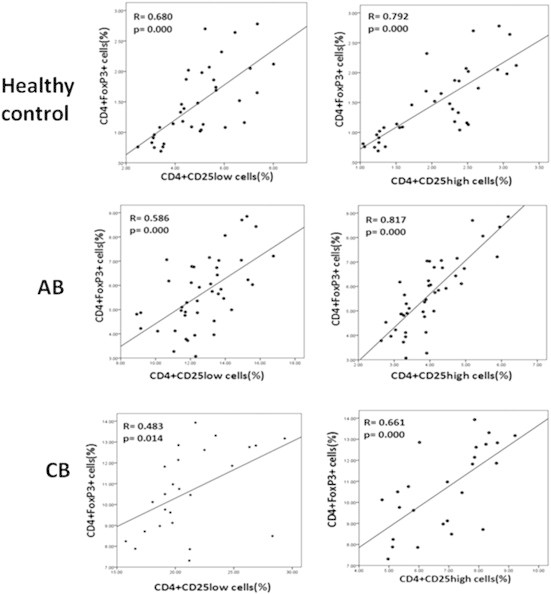Articles
- Page Path
- HOME > Osong Public Health Res Perspect > Volume 5(3); 2014 > Article
-
Original Article
Frequencies of CD4+ T Regulatory Cells and their CD25high and FoxP3high Subsets Augment in Peripheral Blood of Patients with Acute and Chronic Brucellosis - Abbas Bahadora, Jamshid Hadjatib, Niloofar Hassannejadc, Hadi Ghazanfarib, Mohammadreza Maracyd, Sirous Jafarie, Maryam Nourizadehf, Amirhooshang Nejadehg
-
Osong Public Health and Research Perspectives 2014;5(3):161-168.
DOI: https://doi.org/10.1016/j.phrp.2014.04.008
Published online: May 15, 2014
aDepartment of Microbiology, Faculty of Medicine, Tehran University of Medical Sciences, Tehran, Iran
bDepartment of Immunology, Faculty of Medicine, Tehran University of Medical Sciences, Tehran, Iran
cDepartment of Cellular and Molecular Biology, Faculty of Sciences, Science and Research Branch of Islamic Azad University, Tehran, Iran
dDepartment of Biostatistics and Epidemiology, School of Medicine, Isfahan University of Medical Sciences, Isfahan, Iran
eDepartment of Infectious Diseases, Imam Khomeini Hospital, Tehran University of Medical Sciences, Tehran, Iran
fImmunology, Asthma and Allergy Research Institute, Children Medical Center, Tehran University of Medical Sciences, Tehran, Iran
gNejadeh Med lab, Varamin, Iran
- ∗Corresponding author. hd.ghazanfari@gmail.com
© 2014 Published by Elsevier B.V. on behalf of Korea Centers for Disease Control and Prevention.
This is an open access article under the CC BY-NC-ND license (http://creativecommons.org/licenses/by-nc-nd/3.0/).
Abstract
-
Objectives
- Brucellosis remains one of the most common zoonotic diseases worldwide. In humans, brucellosis can be a serious, debilitating, and sometimes chronic disease. Different mechanisms can be postulated as to the basis for the induction of the chronic status of infectious diseases that T regulatory cells are one of the most important related mechanisms. The current study was designed to determine whether percentage of CD4+Treg cells and their CD25high and FoxP3high subpopulations in peripheral blood are changed in human brucellosis samples in comparison to a control group.
-
Methods
- In total, 68 brucellosis patients (acute form: n = 43, chronic form: n = 25) and 36 healthy volunteers entered our study. After isolating of peripheral blood mononuclear cells, heparinized venous blood samples were obtained from both patients and healthy donors, CD4, CD25, and FoxP3 molecules were evaluated by two- and three-color flow cytometric methods.
-
Results
- The results revealed a new finding in relation to Treg cells and human brucellosis. The numbers of CD4+Treg cells and their CD25high and FoxP3high subsets increase significantly in the peripheral blood of acute and chronic forms of brucellosis samples compared with healthy groups, with this increase being greater in the chronic group.
-
Conclusion
- There seems to be a correlation between increase of CD4+Treg cells and their subsets and the disease progress from healthy state to acute and chronic brucellosis.
- Brucellosis is an intracellular bacterial infection with worldwide distribution with > 500,000 human cases reported annually [1,2]. The disease is caused by organisms of the genus Brucella, especially by Brucella melitensis, and is known as the most common zoonotic disease [3]. In humans, the disease culminates in high clinical morbidity and diverse clinical manifestations, as any organ can be affected [4]. Despite early diagnosis and treatment, approximately 10–30% of patients develop chronic disease [5,6].
- Host protection against intracellular pathogens such as Brucella spp. depends on cell-mediated immunity (CMI) [7,8]. Brucella can survive within macrophages of the host and invades the normal mechanisms of bacterial killing, causing chronic disease [6,7]. Th1 related cytokines [interleukin (IL)-12 and interferon-γ], which are fundamental for the clearance of brucellosis agent, and percentages of ex vivo and phytohemagglutinin (PHA)-cultured CD4+ T lymphocytes are found to be diminished in chronic patients [9–11].
- In recent years, regulatory T cells (Tregs) have become a popular subject for immunological research. Numerous reports shed light on the major aspects of Treg biology in humans, with the characterization of different T-cell subpopulations, including naturally occurring CD4+ CD25+Tregs, induced Tregs [IL-10 producing CD4+ type I regulatory T cells (Tr1) and T helper type 3 (Th3) cells], and CD4+ CD25+ T cells that develop in the periphery by conversion of CD4+ CD25– T cells. All these different T-cell populations with regulatory function coexist and contribute to immune suppression [12–14].
- There is now considerable evidence that CD4+ CD25+ Tregs represent a stable population of peripheral lymphocytes. These CD4+ CD25+ Tregs represent about 5–10% of human CD4+ T cells, and are commonly identified by the constitutive expression of IL-2 receptor α (IL-2Ra; CD25), as well as the transcription factor scurfin, encoded by the forkhead family transcription factor 3 (Foxp3) gene [15], and are also characterized by their very low levels of proliferation on T-cell receptor (TCR) stimulation in vitro. The CD4+ CD25high subset (which has high levels of CD25 expression) in normal individuals comprises about 1–3% of human circulating CD4+ T cells. Unlike the total population of CD4+ CD25+ T cells, these CD4+ CD25high cells constitutively expressing FoxP3 molecules at high levels can significantly inhibit the proliferation and cytokine secretion induced by TCR cross-linking of CD4+ CD25− responder T cells, CD8+ T cells, dendritic cells, natural killer cells, and B cells [16–20]. However, FoxP3 is emerged transiently in CD25low CD4+T lymphocytes, which may be without suppressive activities; but they contain effector functions [21].
- The role of CD4+CD25hiT and CD4+FoxP3hiT cells in immunopathology of Brucella infection has not yet been elucidated [22]. So, in our study these cells were evaluated to determine two substantial questions: is the frequency of CD4+CD25highT, CD4+FoxP3highT, CD4+CD25highFoxP3+, and CD4+CD25+FoxP3high cells increased in the peripheral blood (PB) of patients with acute or chronic brucellosis as a direct result and, if so, can these Treg cells impinge on antibacterial immune responses as an inductive result, like other infectious diseases.
Introduction
- 2.1 Participants
- There were 104 unrelated participants enrolled in the study: 68 brucellosis patients; and 36 healthy age- and gender-matched volunteers who were used as controls. According to disease history, clinical picture, and laboratory findings, patients were divided into acute (AB) and chronic (CB) brucellosis groups (Table 1).
- The AB group included 43 consecutive patients. All AB patients had a disease duration ≤8 weeks (mean ± standard deviation, 3.5 ± 2.3 weeks). The diagnosis was based on compatible clinical picture (Table 2) in combination to high serum titers of anti-brucellar antibodies or fourfold increase of the initial titers in two paired samples drawn 2 weeks apart. In addition, in 19 out of 43 AB patients, Brucella melitensis was isolated in blood culture. In 33 patients brucellar DNA was detected by PCR analysis in the blood and the serum.
- The CB group was composed of 25 patients. All CB patients had disease duration ≥6 months [23]. Thirteen of 22 CB patients had also positive PCR analysis in the blood.
- High specific titers were defined by anti-brucellar antibodies, which were considered for the Wright agglutination test ≥1:320, for the Coombs' agglutination test ≥1:320, and for the complement fixation test ≥32. Healthy volunteers were tested serologically for brucellosis and found to be negative.
- 2.2 Flow cytometry
- Surface CD4 and CD25, and intracellular FoxP3 expression were assessed by flow cytometry using the eBioscience human regulatory T cell staining kit Number 3 (eBioscience, San Diego, CA, USA). In brief, PB mononuclear cells (PBMCs) were obtained by Ficoll–Hypaque density gradient centrifugation. Cells were incubated with FITC anti-human CD4 (RPA-T4) and PE anti-human CD25 (BC96) for 30 minutes at 4°C.Then, after twice washing and fixing with fixation/permeabilization solutions, the cells were stained with PE-Cy5 anti-human FoxP3 (PH101), and incubated similarly. Finally, two- and three-color fluorescence flow cytometric analysis by a BD FACS Calibur system were used to demonstrate the frequency of CD4+CD25+, CD4+ FoxP3+ and CD4+CD25+FoxP3+ cells in PB samples.
- 2.3 Statistical analysis
- Parametric statistical tests were applied as the variables were distributed normally (Kolmogorov–Smirnov test). Data were analyzed by one-way analysis of variance using SPSS version 21 (SPSS Inc., Chicago, IL, USA) and were represented as mean ± SD. A p value <0·05 was considered to be statistically significant.
- 2.4 Ethics statement
- Our study was confirmed by the ethical committee of Tehran University of Medical Sciences, Tehran, Iran. The participants were informed about the study and they chose whether or not to participate in this study.
Materials and methods
- 3.1 CD4+Treg cells and their subsets
- The percentages of Treg cells were calculated as the frequencies of CD4+CD25+, CD4+CD25high, CD4+FoxP3+, CD4+FoxP3high, CD4+CD25+FoxP3+, CD4+CD25highFoxP3+, and CD4+CD25+FoxP3high cells in the CD4+ population of PBMCs, and their frequencies were 6.7%, 2.0%, 1.5%, 0.4%, 1.4%, 0.41%, and 0.4% of CD4+ cells, respectively, in PBMCs of healthy age-matched controls (Table 3, Figures 1 and 2). FoxP3+ cells, similar to CD25+cells, were classified into two subsets (FoxP3high and FoxP3low) based on the intensity of FoxP3 expression (Figure 3).
- The proportions of CD4+CD25+ cells included 16.6% in AB and 27.6% in CB patients. Also, the CD25high subset of these cells contained 3.9% in AB and 6.8% in CB patients (Table 3, Figures 1 and 2).
- CD4+FoxP3+ cells accounted for 5.7% of CD4+T-cells in AB and 10.6% of CD4+T cells in CB patients. In total CD4+lymphocytes, FoxP3high subpopulation consisted of 1.6% and 2.9% in AB and CB, respectively.
- In patients with AB, CD4+CD25+FoxP3+cells comprised 5.06% of total CD4+ lymphocytes; in CB patients, percentage of these cells was 9.5% of total CD4+ lymphocytes (Table 3).
- CD4+CD25highFoxP3+cells subtended 1.28% of CD4+ lymphocytes in AB and 2.45% in CB patients. Moreover, frequencies of CD4+CD25+FoxP3high cells encompassed 1.41% and 2.03% of CD4+ lymphocytes in attribution of AB and CB patients, respectively (Table 3, Figure 3).
- 3.2 Correlation between the level of CD25 expression in CD4+ lymphocytes and CD4+FoxP3+cells
- Correlation coefficients of CD4+CD25high cells and CD4+FoxP3+ cells in the three groups consisted of R = 0.792, p < 0.001 (healthy control), R = 0.817, p < 0.001 (AB), and R = 0.661, p < 0.001 (CB) versus correlation between CD4+CD25low cells and CD4+FoxP3+ cells with coefficients including R = 0.680, p < 0.001 (healthy control), R = 0.586, p < 0.001 (AB), and R = 0.483, p = 0.014 (CB; Figure 4).
Results
- Regulatory T cells (Treg cells) were originally identified through their function in controlling autoimmunity, where they mediate immunological tolerance to self-antigens [24]. However, it later became apparent that Treg cells also control immune responses to foreign antigens on pathogens [25]. The function of Treg cells during infection appears to be primarily to prevent collateral damage from unrestrained immune responses to the pathogen, with a number of studies demonstrating enhanced immunopathology with defective or depleted Treg cells. It also seems that the induction of Treg cells during infection is an immune subversion strategy engaged by certain pathogens in order to last their survival in the host [26].
- In agreement with other studies [11,27], we found that the percentage expression of IL-2 receptor α on peripheral CD4+lymphocytes in the healthy group was <10% (data not shown). Also, in the current study, > 90% of FoxP3+ cells in all three groups were CD4+FoxP3+ (data not shown), which implies that the majority of FoxP3+Treg cells in healthy individuals, AB, and CB patients manifest surface CD4 molecules.
- In our study, the percentage of peripheral CD4+CD25+(low or high) T-lymphocytes was increased in AB patients, as compared to controls, suggesting that helper T-cells are activated in AB. This finding adds further support to data presented by other researchers [11,28,29] and it approves that CD25 is upregulated in AB patients. CB patients showed significantly increased percentage of CD25 expression on peripheral CD4+CD25high lymphocytes in comparison to AB patients. This seems to be in contrast with a previous study by Skendros et al [11], which showed diminished percentage in CD25 expression on peripheral CD4+T cells in compared with AB. But, they use PHA in the culture of obtained PBMC for activating and proliferating of lymphocytes and for this the acute brucellosis group has the higher level of CD4+CD25low cells as CD4+T-helper cells, were activated and proliferated more than other groups. By contrast, the increase of CD4+CD25high cells in PB of CB patients and induced suppression of T cells by this Treg cells, appears to be a substantial reason for the significant reduction in the percentage of PHA-proliferating TCD4+CD25+ cells and anergy induction in CB [30].
- In addition, in our research, there were significant increases in the proportions of CD4+FoxP3+cells and their FoxP3high subpopulation, as well as CD4+CD25+FoxP3+ cells and their CD25high or FoxP3high subsets in CB in comparison to AB patients and healthy controls. Also, CD4+CD25high Treg cells in the AB group showed a significant increase in frequencies compared with the control group.
- According to Curiel et al [31], FoxP3 expression in low levels can cause differentiation of Treg cells to Th2 or Th17 cells. So, the intensity of FoxP3 expression is crucial in the state of Treg suppressive activity. In fact, the presence of FoxP3 molecule maybe not only function as an on-and-off switch to offer suppressive activity of Treg cells but also control the regulatory capacity of these cells owing to the decreased function of Treg cells due to attenuated FoxP3 expression [32]. Consequently, our report about an increase of FoxP3+CD4+Treg subsets in AB and CB patients versus control volunteers indicates a significant rising trend in suppressive activities of the immune response in parallel with an ongoing infection such as brucellosis.
- By contrast, we found the relationship between CD4+CD25high and CD4+FoxP3+ cells displayed a stronger power of correlation coefficient than CD4+CD25low and CD4+FoxP3+ cells in all three groups. This positive correlation verifies the direct relationship between the high-level intensity of CD25 (CD25high) and FoxP3 expression. Also, the AB group (R = 0.817) showed a better correlation of CD4+CD25high and CD4+FoxP3+ cells compared with the two other groups [R(healthy group) = 0.792; R(CB) = 0.661], which may be due to the larger sample size of the AB group (Figure 4).
- In conclusion, our results demonstrate that there is a marked increase in circulating CD4+ CD25+, CD4+FoxP3+, and CD4+CD25+FoxP3+ Tregs and their CD25high or FoxP3high subpopulations in AB and CB patients. Tregs play a negative role not only in modulating the effectors of immune responses by inhibiting interferon-γ secretion and cellular proliferation upon Brucella antigen stimulation, but also in influencing the disease persistence in CB. These findings suggest that modulation of CD4+ CD25+ Tregs might be one potential therapeutic strategy for the treatment of the chronic form of this infection. However, this study was limited by analysis of the PB compartment only, and further detailed investigation of the level and function of CD4+ CD25+ and CD4+FoxP3+Tregs in brucellosis needs to be carried out.
Discussion
- The authors report no conflicts of interest. The authors alone are responsible for the content and writing of the paper.
Conflicts of interest
-
Acknowledgements
- This study was financed by the vice chancellor for research, Tehran University of Medical Sciences 90-62-30-13976. We would like to thank all participants who took part in our study and helped us.
Acknowledgments
-
This is an Open Access article distributed under the terms of the Creative Commons Attribution Non-Commercial License (http://creativecommons.org/licenses/by-nc/3.0) which permits unrestricted non-commercial use, distribution, and reproduction in any medium, provided the original work is properly cited.
Article information
- 1. Pappas G., Akritidis N., Bosilkovski M.. Brucellosis. N Engl J Med 352(22). 2005 Jun 2;2325−2336. PMID: 15930423.Article
- 2. Pappas G., Papadimitriou P., Akritidis N.. The new global map of human brucellosis. Lancet Infect Dis 6(2). 2006 Feb;91−99. PMID: 16439329.ArticlePubMed
- 3. Seleem M.N., Boyle S.M., Sriranganathan N.. Brucellosis: a re-emerging zoonosis. Vet Microbiol 140(3). 2010 Jan 27;392−398. PMID: 19604656.Article
- 4. Skendros P., Boura P., Kamaria F.. CD80/CD28 co-stimulation in human brucellosis. Clin Exp Immunol 146(3). 2006;400−408. PMID: 17100758.ArticlePubMedPMC
- 5. Memish Z.A., Balkhy H.H.. Brucellosis and international travel. J Travel Med 11(1). 2004 Jan–Feb;49−55. PMID: 14769288.ArticlePubMed
- 6. Jimenez de Bagues M.P., Dudal S., Dornand J.. Cellular bioterrorism: how Brucella corrupts macrophage physiology to promote invasion and proliferation. Clin Immunol 114(3). 2005 Mar;227−238. PMID: 15721833.ArticlePubMed
- 7. Golding B., Scott D.E., Scharf O.. Immunity and protection against Brucella abortus. Microbes Infect 3(1). 2001 Jan;43−48. PMID: 11226853.ArticlePubMed
- 8. Yingst S., Hoover D.. T cell immunity to brucellosis. Crit Rev Microbiol 29(4). 2003;313−331. PMID: 14636042.ArticlePubMed
- 9. Giambartolomei G.H., Delpino M.V., Cahanovich M.E.. Diminished production of T helper 1 cytokines correlates with T cell unresponsiveness to Brucella cytoplasmic proteins in chronic human brucellosis. J Infect Dis 186(2). 2002 Jul 15;252−259. PMID: 12134263.Article
- 10. Rafiei A., Ardestani S.K., Kariminia A.. Dominant Th1 cytokine production in early onset of human brucellosis followed by switching towards Th2 along prolongation of disease. J Infect 53(5). 2006 Nov;315−324. PMID: 16488475.ArticlePubMed
- 11. Skendros P., Boura P., Chrisagis D.. Diminished percentage of CD4+ T-lymphocytes expressing interleukine-2 receptor alpha in chronic brucellosis. J Infect 54(2). 2007 Feb;192−197. PMID: 16720045.ArticlePubMed
- 12. Edited by Mills K.H., McGuirk P.: Antigen-specific regulatory T cells—their induction and role in infection. Seminars in immunology. 2004. Elsevier; Philadelphia.
- 13. Vigouroux S., Yvon E., Biagi E.. Antigen-induced regulatory T cells. Blood 104(1). 2004 Jul 1;26−33. PMID: 15026316.Article
- 14. Sakaguchi S.. Naturally arising Foxp3-expressing CD25+ CD4+ regulatory T cells in immunological tolerance to self and non-self. Nat Immunol 6(4). 2005 Apr;345−352. PMID: 15785760.ArticlePubMed
- 15. Hori S., Nomura T., Sakaguchi S.. Control of regulatory T cell development by the transcription factor Foxp3. Science 299(5609). 2003 Feb 14;1057−1061. PMID: 12522256.Article
- 16. Bacchetta R., Gambineri E., Roncarolo M.G.. Role of regulatory T cells and FOXP3 in human diseases. J Allergy Clin Immunol 120(2). 2007 Aug;227−235. quiz 236–7. PMID: 17666212.ArticlePubMed
- 17. Lim H.W., Hillsamer P., Banham A.H.. Cutting edge: direct suppression of B cells by CD4+ CD25+ regulatory T cells. J Immunol 175(7). 2005 Oct 1;4180−4183. PMID: 16177055.Article
- 18. Azuma T., Takahashi T., Kunisato A.. Human CD4+ CD25+ regulatory T cells suppress NKT cell functions. Cancer Res 63(15). 2003 Aug 1;4516−4520. PMID: 12907625.
- 19. Romagnani C., Della Chiesa M., Kohler S.. Activation of human NK cells by plasmacytoid dendritic cells and its modulation by CD4+ T helper cells and CD4+ CD25hi T regulatory cells. Eur J Immunol 35(8). 2005 Aug;2452−2458. PMID: 15997468.ArticlePubMed
- 20. Trzonkowski P., Szmit E., Myśliwska J.. CD4+ CD25+T regulatory cells inhibit cytotoxic activity of T CD8+ and NK lymphocytes in the direct cell-to-cell interaction. Clin Immunol 112(3). 2004 Sep;258−267. PMID: 15308119.ArticlePubMed
- 21. Miyara M., Yoshioka Y., Kitoh A.. Functional delineation and differentiation dynamics of human CD4+ T cells expressing the FoxP3 transcription factor. Immunity 30(6). 2009 Jun 19;899−911. PMID: 19464196.Article
- 22. Sales P.A. Jr., Golgher D., Oliveira R.V.. The regulatory CD4+ CD25+ T cells have a limited role on pathogenesis of infection with Trypanosoma cruzi. Microbes Infect 10(6). 2008;680−688. PMID: 18485782.ArticlePubMed
- 23. Irmak H., Buzgan T., Karahocagil M.K.. The effect of levamisole combined with the classical treatment in chronic brucellosis. Tohoku J Exp Med 201(4). 2003 Dec;221−228. PMID: 14690014.ArticlePubMed
- 24. Sakaguchi S., Sakaguchi N., Asano M.. Immunologic self-tolerance maintained by activated T cells expressing IL-2 receptor alpha-chains (CD25). Breakdown of a single mechanism of self-tolerance causes various autoimmune diseases. J Immunol 155(3). 1995 Aug;1151−1164. PMID: 7636184.PubMed
- 25. McGuirk P., Mills K.H.. Pathogen-specific regulatory T cells provoke a shift in the Th1/Th2 paradigm in immunity to infectious diseases. Trends Immunol 23(9). 2002 Sep;450−455. PMID: 12200067.ArticlePubMed
- 26. Mills K.H.. Regulatory T cells: friend or foe in immunity to infection? Nat Rev Immunol 4(11). 2004;841−855. PMID: 15516964.ArticlePubMed
- 27. Bueno L.L., Morais C.G., Araujo F.F.. Plasmodium vivax: induction of CD4+CD25+FoxP3+ regulatory T cells during infection are directly associated with level of circulating parasites. PLoS One 5(3). 2010 Mar 10;e9623PMID: 20224778.Article
- 28. Refik M., Mehmet N., Durmaz R.. Cytokine profile and nitric oxide levels in sera from patients with brucellosis. Braz J Med Biol Res 37(11). 2004 Nov;1659−1663. PMID: 15517081.ArticlePubMed
- 29. Makis A.C., Galanakis E., Hatzimichael E.C.. Serum levels of soluble interleukin-2 receptor alpha (sIL-2Rα) as a predictor of outcome in brucellosis. J Infect 51(3). 2005 Oct;206−210. PMID: 16230217.ArticlePubMed
- 30. Boura P., Tsapas G., Kountouras J.. Interferon-A 2a administration in chronic anergic brucellosis. Hepatogastroenterology 42(6). 1994 Nov–Dec;919−922. PMID: 8847046.
- 31. Curiel T.J.. Regulatory T-cell development: is Foxp3 the decider? Nat Med 13(3). 2007 Mar;250−253. PMID: 17342117.ArticlePubMed
- 32. Wan Y.Y., Flavell R.A.. Regulatory T-cell functions are subverted and converted owing to attenuated Foxp3 expression. Nature 445(7129). 2007;766−770. PMID: 17220876.ArticlePubMed
References




| AB | CB | Healthy control | |
|---|---|---|---|
| N | 43 | 25 | 36 |
| Female | 14 | 8 | 13 |
| Male | 29 | 17 | 23 |
| Age (mean ± standard deviation, y) | 43.5 ± 19.2 | 48.7 ± 14.3 | 42.6 ± 15.2 |
Figure & Data
References
Citations

- High-dimensional profiling of regulatory T cells in psoriasis reveals an impaired skin-trafficking property
Brian Hyohyoung Lee, Yoon Ji Bang, Sung Ha Lim, Seong-Jun Kang, Sung Hee Kim, Seunghee Kim-Schulze, Chung-Gyu Park, Hyun Je Kim, Tae-Gyun Kim
eBioMedicine.2024; 100: 104985. CrossRef - Investigation of IL-35 and IL-39, New Members of the IL-12 Family, in Different Clinical Presentations of Brucellosis
Pınar Hız Ellergezen, Muhammed Ali Kizmaz, Abdurrahman Simsek, Nesrin Demir, Eren Cagan, S. Haldun Bal, E. Halis Akalin, H. Barbaros Oral, Ferah Budak
Immunological Investigations.2023; 52(3): 286. CrossRef - In obese hypertensives cholecalciferol inhibits circulating TH17 cells but not macrophage infiltration on adipose tissue
Catarina Santos, Andreia Monteiro, Ricardo Rodrigues, Catarina Ferreira, Joana Coutinho, Rui Filipe, Sância Ramos, Miguel Castelo Branco, Mafalda Fonseca
Clinical Immunology.2023; 247: 109244. CrossRef - The mechanism of chronic intracellular infection with Brucella spp.
Xiaoyi Guo, Hui Zeng, Mengjuan Li, Yu Xiao, Guojing Gu, Zhenhui Song, Xuehong Shuai, Jianhua Guo, Qingzhou Huang, Bo Zhou, Yuefeng Chu, Hanwei Jiao
Frontiers in Cellular and Infection Microbiology.2023;[Epub] CrossRef - The potential role of infusions of T regulatory cells in inducing and maintaining liver allograft tolerance
Jihad Aljabban, William Burlingham, Michael R. Lucey
Clinical Liver Disease.2023; 22(4): 146. CrossRef - Intragraft regulatory T cells in the modern era: what can high-dimensional methods tell us about pathways to allograft acceptance?
Ke Fan Bei, Sajad Moshkelgosha, Bo Jie Liu, Stephen Juvet
Frontiers in Immunology.2023;[Epub] CrossRef - Immunosuppressive Mechanisms in Brucellosis in Light of Chronic Bacterial Diseases
Joaquin Miguel Pellegrini, Jean-Pierre Gorvel, Sylvie Mémet
Microorganisms.2022; 10(7): 1260. CrossRef - Immune effects of CDK4/6 inhibitors in patients with HR+/HER2− metastatic breast cancer: Relief from immunosuppression is associated with clinical response
Fabio Scirocchi, Simone Scagnoli, Andrea Botticelli, Alessandra Di Filippo, Chiara Napoletano, Ilaria Grazia Zizzari, Lidia Strigari, Silverio Tomao, Enrico Cortesi, Aurelia Rughetti, Paolo Marchetti, Marianna Nuti
eBioMedicine.2022; 79: 104010. CrossRef - Cell-Mediated Therapies to Facilitate Operational Tolerance in Liver Transplantation
Samia D. Ellias, Ellen L. Larson, Timucin Taner, Scott L. Nyberg
International Journal of Molecular Sciences.2021; 22(8): 4016. CrossRef - Exploring cannabidiol effects on inflammatory markers in individuals with cocaine use disorder: a randomized controlled trial
Florence Morissette, Violaine Mongeau-Pérusse, Elie Rizkallah, Paméla Thébault, Stéphanie Lepage, Suzanne Brissette, Julie Bruneau, Simon Dubreucq, Emmanuel Stip, Jean-François Cailhier, Didier Jutras-Aswad
Neuropsychopharmacology.2021; 46(12): 2101. CrossRef - Effects of indoleamine 2, 3‐dioxygenase (IDO) silencing on immunomodulatory function and cancer‐promoting characteristic of adipose‐derived mesenchymal stem cells (ASCs)
Fahimeh Heidari, Mahboobeh Razmkhah, Vahid Razban, Nasrollah Erfani
Cell Biology International.2021; 45(12): 2544. CrossRef - Impact of immune checkpoint molecules on FoxP3+ Treg cells and related cytokines in patients with acute and chronic brucellosis
Hua-Li Sun, Xiu-Fang Du, Yun-Xia Tang, Guo-Qiang Li, Si-Yuan Yang, Ling-Hang Wang, Xing-Wang Li, Cheng-Jie Ma, Rong-Meng Jiang
BMC Infectious Diseases.2021;[Epub] CrossRef - Meta-Analysis of the Changes of Peripheral Blood T Cell Subsets in Patients with Brucellosis
Rongjiong Zheng, Songsong Xie, Shaniya Niyazi, Xiaobo Lu, Lihua Sun, Yan Zhou, Yuexin Zhang, Kai Wang
Journal of Immunology Research.2018; 2018: 1. CrossRef - Assessment of TGF-β and IL10 levels in human brucellosis
Mousa Mohammadnia-Afrouzi, Soheil Ebrahimpour
Current Issues in Pharmacy and Medical Sciences.2018; 31(1): 22. CrossRef


 PubReader
PubReader Cite
Cite
